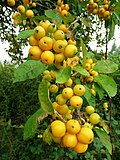| Malus prunifolia | |
|---|---|
 | |
| Malus prunifolia [1] | |
| Scientific classification | |
| Kingdom: | Plantae |
| Clade: | Tracheophytes |
| Clade: | Angiosperms |
| Clade: | Eudicots |
| Clade: | Rosids |
| Order: | Rosales |
| Family: | Rosaceae |
| Genus: | Malus |
| Species: | M. prunifolia |
| Binomial name | |
| Malus prunifolia | |
Malus prunifolia is a species of crabapple tree known by the common names plumleaf crab apple, [4] plum-leaved apple, [5] pear-leaf crabapple, Chinese apple and Chinese crabapple. [6] It is native to China.
Contents
The number of chromosomes is 2n = 34. [7]

